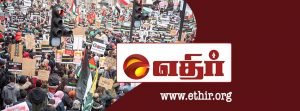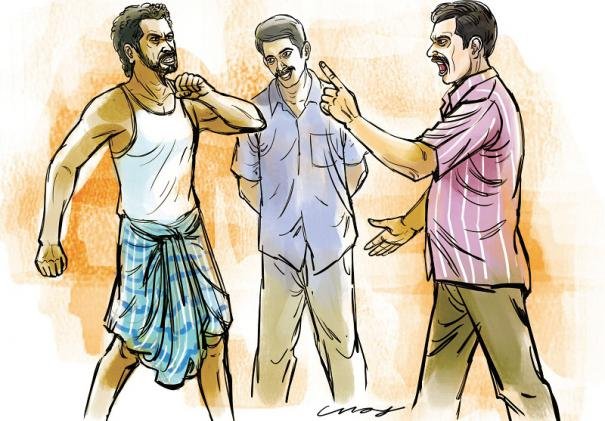1983 pogrom and the beginning of civil war
An organised attack by the elite – not a spontaneous ethnic riot
The 1983 pogroms stand as a stark moment in the history of Sri Lankan politics. Much myth-making has surrounded the events – mainly invented by the right-wing politicians who were the architects of the violence. Understanding the true processes that took place is key to building a strong resistance to the current dictatorial regime. Here we publish an account based on thorough research into the facts.
Please get in touch to discuss this account or to find out more about Tamil Solidarity.
In 1983 the Liberation Tigers of Tamil Eelam (LTTE) ambushed a military truck and killed 13 soldiers on 23 July. The UNP government reacted quickly to capitalise on this incident. Instead of following regular procedures, a mass funeral for the soldiers was planned in Colombo. UNP minister Cyril Mathew, with other right-wing members of the government, planned riots and attacks on the funeral day. A wealth of information has since emerged indicating how leading members of the UNP government played the leading role in organising the mobs. It appeared they had been waiting for such an ‘opportunity’ to present itself.
Sirisena Cooray, a leading UNP member, later pointed out that President JR Jayewardene had been completely aware of the situation. Cooray wrote: “This was madness. Like Mr Premadasa (then prime minister) I knew that all hell was likely to break lose when those bodies are brought to Colombo…If the President listened to Mr Premadasa, the 1983 July riots could have been avoided and the history of this country would have been different.” Cooray also pointed out that: “There was an organised crowd present, making a huge show of grief, weeping hysterically.” Mr Premadasa himself later joined the gangs, not to miss out on the opportunity to gain control (or authority) among the communalists!
Jayewardene expressed the mindset of the communal thugs throughout his political career. Soon after his election victory he announced “…I am not worried about the opinion of the Jaffna people now… Now we cannot think of them. Not about their lives or of their opinion about us…The more you put pressure in the north, the happier the Sinhala people will be here…really, if I starve the Tamils out, the Sinhala people will be happy…” This, and his infamous declaration of war, ‘If you want a fight, let there be a fight; if it is peace, let there be peace’, had already given a massive boost to the communal forces. The UNP’s brutal suppression of the general strike in 1980 also the key turning point htat gave the Sinhala nationalist a commanding position within the government. Several acts of violence took place in the south against Tamils even before 1983. These were completely ignored by the government even after repeated requests for take action.
On 24 July the bodies of 13 soldiers were brought to Colombo. Organised mobs began to attack the Tamils in the South. Soon attacks begun to spread to southern parts of the country. The government declared a curfew and the police and military were called in. But government forces were used as protection for the mobs. They used government vehicles to move around. The media around the world reported how the mobs used the electoral register to identify Tamil properties and went door to door. More than 50 Tamils were murdered even before the 13 soldiers’ death and its details properly published in the media. The communalists spread numerous rumours; one example was that the LTTE was coming to the south to attack Sinhala people.
Between 400 and 3,000 people were killed in a day. More than 18,000 homes were damaged. More than 100 industrial plants and 20 garment factories were destroyed. Around 150,000 people lost their jobs and over 100,000 people were made refugees. The next day 53 political prisoners were killed in prison. The brutal killings that took place in the notorious Welikada high security prison sent shock wave across the Tamil-speaking areas. All the political prisoners, including LTTE members retained under the prevention of terrorism law, were cruelly tortured and murdered. Some of the prisoners who escaped that brutality and still live in various parts of the world explained how Sinhala prisoners helped Tamil prisoners to escape the mob’s attack. The government maintained that it was angry Sinhala prisoners who attacked and killed Tamil prisoners. This was a complete fabrication.
Throughout the south it was ordinary Sinhala people who came forward to defend the Tamils from the attacks. They risked their own lives by hiding their Tamil friends in their homes and by defending them in the street. A number of Sinhala people were also attacked as a result.
The government that brutally attacked and weakened the trade union and workers’ movements during the 1980 strike now had no opposition.
While this was going on the president retreated to the presidential palace after saying “the time has come to accede to the clamour and the national respect of the Sinhala people” which he repeated again after the attacks. It took 24 hours for the government to introduce a curfew. The president did not speak a word for four days. Finally when he spoke after four days he claimed that this attack was carried out by the Sinhala people and declared that it was time that the Sinhala people were given national respect. The minister of state, Ananda Tissa de Alwis, then publicly accepted that this attack was well-planned and carried out by the organised mob. He went on to blame the left parties for planning the attack. But like Siritunga Jayasuriya, then leading member of the NSSP and now general secretary of the United Socialist Party (USP), many Sinhala workers had hidden Tamils in their houses and fought against the mobs to save the lives of the Tamil people. But the Jayewardene government mentality can be summarised in the interview he gave to New International in 1981. He declared:
“The political decisions I have taken may have been right or wrong but that doesn’t matter. In my own behaviour, there is nothing to be ashamed of. I have done nothing mean. I know they say I am a strategist and a schemer but you cannot be a leader unless you scheme – not in politics or in war or in any human affair. Even a boxer has to scheme – and I was a boxer when I was young – you pretend to hit the face but you hit the stomach. Oh yes, you have to scheme.”
This cunning schemer pretended that he represented ordinary Sinhala people, but hit them hard in their rights and organised an attack against minorities to maintain his position in power.
Even right-wing historians, such as AJ Wilson who was in close contact with the UNP leadership at that time, agree that “Jayewardene was out of control of the situation”. Quite incredibly Jayewardene even wrote to the Tamil opposition leader A Amirthalingam not to come to Colombo because he could “not guarantee his safety”. The Tamil United Liberation Front (TULF) leaders were forced to escape to India.
What happened in Black July 1983 was not an ethnic riot where Sinhala masses spontaneously attacked Tamil minorities. This was an organised attack by the ruling elite. To this day no thorough investigation has been carried out or compensation given to the victims.
The 1983 killings are considered a turning point in Sri Lankan history. The 1983 pogroms made sure that Tamil armed struggle got all the support they needed from the Tamil masses. Numerous youth from all over the country either joined the existing militant groups or formed new ones. Some young people also joined the Janathā Vimukthi Peramuṇa (People’s Liberation Front, JVP). Quite significantly the JVP was able to recruit Tamil youth from the plantations. During the early 80s some movements (as they were called by the people) came to dominate.


















